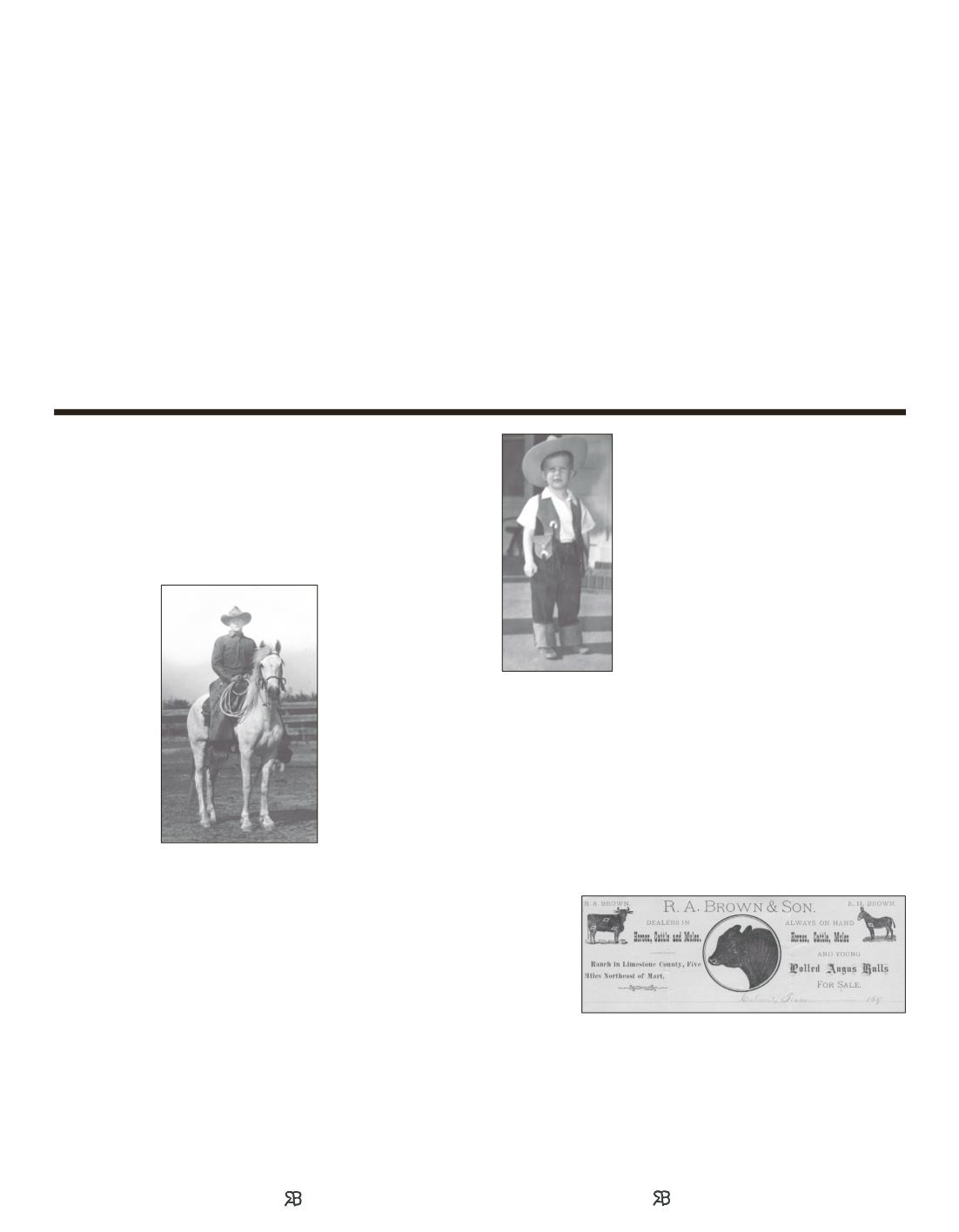
Robert Alexander Brown was a native
of Virginia, born in Culpepper County, near
Brandywine Station, February 22, 1833. He
grew up working with cotton, cattle, horses
and mules. Upon coming to Texas at age 17
he located in Galveston and was employed as
a salesman in a mercantile business.
When the Civil War broke out, he returned
to the family plantation in his native state
and county and volunteered defending the
cause of the Confederate States. He was a
member of the famous Black-Horse Cavalry
of Virginia under Jeb Stuart and as a soldier
served with distinguished bravery in various
battles defending the Confederate capitol
until his capture in the Valley of the Potomac
in 1864.
After the Civil War, he was released and
returned to Galveston where he entered
the cotton export business and became a
commission merchant. These ancestors
farmed cotton and traded mules back and
forth from Missouri.
They later moved to Calvert, Texas where
Robert Herndon (R.H.) Brown, the oldest
son, was in the cattle business. Records show
he sold Angus bulls in the 1890s and even
sent a boat load of cattle to Cuba in 1895.
R.H. Brown moved to Jack County,
Texas where he had a small ranch and his
son R. A. Brown was born in 1902. When
the Fort Worth Stockyards opened in 1903,
R.H. Brown sold the ranch and bought an
interest in a cattle commission company
there. That same year he started buying land
in Throckmorton County.
1906 —
R.H. Brown brought the first
registered Hereford cattle toThrockmorton
County and started selling bulls there.
R.A. Brown grew up working at the Fort
Worth Stockyards and during the summers
worked at the ranch in Throckmorton.
1917 —
At the age of 15, R. A. Brown
enrolled
in
school
at
Woodson, TX
so that he could
stay and help
at the ranch
through
the
severe drought.
Feed was scarce
and cows were
thin going into
that extremely
cold winter and
cows
began
to die. R. A.
helped
skin
cows (instead of
going to school) and hauled wagon loads
of hides to Abilene, some 60 miles away,
trading them for cotton seed cake to feed
the remaining cattle.
1922 —
R. A. Brown, a student at Texas
A&M, was a member of the collegiate
polo team. He quit school to return to the
ranch due to his father’s declining health
and economic hardships.
1929 —
R.H. Brown dies from a long
bout with cancer. The Great Depression
hits. The family advises R. A. to give up
the ranch. Instead he got his mother and
his sisters to deed their parts of the ranch
to him so he could
borrow enough money
to save it. (He managed
to get the debt paid
off in the 1940’s and
deeded their land back
to them.)
1931 —
R. A. Brown
marries the former
Valda Thomas whose
parents were also
ranchers, Mr. and Mrs.
D.B. Thomas.
1934 —
D. B. Thomas
dies and R. A. Brown
assumes management of the Thomas
Ranch as well as the Brown Ranch raising
commercial as well as registered Hereford
cattle and selling Hereford bulls.
1936 —
R. A. Brown Jr. (Rob) was born
and grew up working on the ranch.
1950-57 —
Ranch destocks from 900 to
125 head of cattle on 18,000 acres
because of severe drought.
1957 —
R. A. (Rob) Brown Jr. and
Peggy Donnell marry. The Donnells,
a long time ranching family, settled
in neighboring Young County in
1876.
1958 —
After graduating from Texas Tech
Rob and Peggy return to Throckmorton to
work with his parents on the ranch. Their
first daughter, Betsy, was born.
1960 —
Rob A. Brown was born. Rob had
the foresight to start a mesquite woodchip
company in Throckmorton and started
marketing it for cooking to give that unique
mesquite flavor.
1965 —
Rob & R. A. agreed to start
crossbreeding the commercial Hereford
cows with Brown Swiss. A week later R.
A. died from a sudden heart attack. Rob
closed the wood company and took over
management of the ranch.
1967 & 1969 —
Marianne & Donnell
Brown were born. The crossbred calves
were 100 pounds heavier at weaning,
but were discounted in the market place
because of the brindle, gray and dun color.
1970—
Simmental took the place of Brown
Swiss in the crossbreeding program which
cured the color and marketing problems,
while keeping the 100 pounds of additional
weaning weight and also improving
percentage calf crop. The herd was bred up
to purebred Simmental and started selling
Simmental & Simmental Hybrid bulls.
1974 —
Rob serves as the 4th President of
American Simmental Association.
1975 —
First Bull Sale - 115 bulls averaged
$578/bull. Top selling bull brought $1175.
1976 —
Simbrah was added to the herd for
more heat tolerance and hybrid vigor to
R. A. Brown
R. A. Brown,
Jr. “Rob”
8
A Century of Heritage


